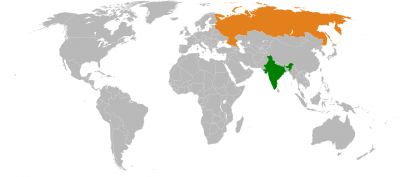Relations Between India and Russia on the Rise

All Global Research articles including the E-Book can be read in 27 languages by activating the “Translate Website” drop down menu on the top banner of our home page (Desktop version).
***
Military relations between Russia and India are increasing and this can bring a series of significant changes in international society. The Indian government recently sent about 100 soldiers to Russia to train them in handling the S-400 anti-aircraft system, which New Delhi plans to acquire as soon as possible. However, this is unlikely to be pleasing to Washington, which sees New Delhi as a key partner in its strategy for the Indo-Pacific region.
In October 2018, India signed a contract with Russian company Rosoboronexport for the purchase of five S-400 anti-aircraft systems for more than 5 billion dollars. At the time, Washington disapproved the negotiation, but as India had not yet received the equipment, tensions eased. However, the Asian country will receive the first anti-aircraft batteries between September and October 2021 and that will be operational later this year or early next year, which worries Americans deeply. New Delhi recently informed that it has already transferred a significant advance payment to Rosoboronexport and is designing a mechanism to make the final payment soon. Meanwhile, the Indians are planning mechanisms to ease their tensions with the US, which has already threatened to impose severe sanctions.
The S-400 is an extremely powerful system, being used by the Russian armed forces since 2007. With a range of hundreds of kilometers and being able to shoot down ballistic missiles, the S-400 can significantly improve Indian national security in the midst of the regional tensions. Indeed, India is rushing to increase the material and human resources of its armed forces, mainly due to the fact that its dispute with China continues. Still, it is necessary to emphasize that, although tensions with China have gained a lot of evidence since May last year (when there were small incidents of direct confrontation and deaths), the dispute between India and Pakistan still remains and generates victims every year, making that region a big focus of tensions, with three nuclear powers involved in territorial disputes.
Throughout the Trump administration, tensions between the US and India due to the agreement with Russia were eased, although they remained. The former American president has warned New Delhi several times to cancel the deal before receiving the equipment. The reason Trump did not make more active interventions in the case is simple: the US and India have a common enemy, China, and the Americans cannot lose this important ally against Beijing. However, now, in the early days of the Biden administration, Washington receives news on the consummation of the agreement between Indians and Russians. Biden, who has a more active attitude towards the imposition of American interests with his defense of global hegemony, will now have to choose between continuing Trump’s policy or taking a more aggressive attitude towards India.
For India, however, the situation has not changed so much. New Delhi has never been interested in forming an ideological alliance with Washington – Indian interest is limited to the existence of a common enemy. To ensure their security against this enemy, Indians seek American support – but if the US does not provide all the resources necessary for India to guarantee its protection, the Indian government will seek this guarantee in other possibilities of cooperation, such as Russia.
What we can see in the Indian case is yet another evidence of the irreversibility of the process of geopolitical multipolarisation – mainly in international trade. India, while a historical ally of the US, seeks to equip itself with Russian armaments and to strengthen commercial and military ties with Russia, because what New Delhi wants is to guarantee its own interests, regardless of which power may be an ally for this. With the rise of trade wars and the wave of international sanctions politically or ideologically motivated, Washington tried to impose on the world a very distorted notion of the function of trade, limiting the exchange of resources between nations to the existence of political and ideological affinities. However, this type of trade limitation cannot be maintained for long, as this would lead to an irreparable global crisis. Knowing this, more and more nations seek to diversify their trade options and maintain ties simultaneously with apparently antagonistic potentials.
With this scenario, it will be up to the new American president to choose between sanctioning India – which will make the US to lose an important ally and push the Indians even further into relations with Russia – or to maintain a peaceful policy of “warnings” and “verbal disapprovals”, without any aggressive commercial measure, accepting the fact that any nation can buy any product – military or not – from any nation.
*
Note to readers: please click the share buttons above or below. Forward this article to your email lists. Crosspost on your blog site, internet forums. etc.
This article was originally published on InfoBrics.
Lucas Leiroz is a research fellow in international law at the Federal University of Rio de Janeiro.
Featured image is from InfoBrics

